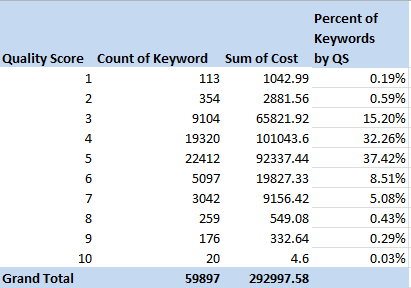The One Minute Paid Search Account Diagnosis
Every PPC manager wants to know how to increase their exposure, especially if they feel there aren’t any new keywords they wish to add. There is a simple way to determine how to increase an account’s exposure that can be accomplished in less than a minute. Generally speaking, when looking to increase your exposure, you […]
Every PPC manager wants to know how to increase their exposure, especially if they feel there aren’t any new keywords they wish to add.
There is a simple way to determine how to increase an account’s exposure that can be accomplished in less than a minute.
Generally speaking, when looking to increase your exposure, you need to know why your exposure is being limited. There are three common reasons why your ads are not being displayed:
- Budget
- Quality score
- Bid prices
In this article, we will look at how to determine what is limiting your exposure, and show how you can do this analysis in less than one minute. In this analysis, we will assume you have expanded your keywords a few times and that you do not wish to add new keywords.
Impression Share Report
Start by running an impression share report. This is a report that can be run at the campaign level and shows you why you’re ads are not being displayed. If you need help running reports or finding all the features, please see this video that walks you through creating reports.
You will now have a view of why your account is not being displayed, through either budget or rank.
Budget Loss
In this first case (above image), the biggest reason that impressions are being lost is because of the budget.
When you lose impressions due to budget, then raising your budget can help get you more clicks that should have the same quality as your current clicks. When you see that you’re losing clicks due to budget you should be careful. If you cannot raise the budget, then you are probably overpaying for each click.
For example,, if your budget is $100 per day and you are paying $1 per click, then you usually receive 100 clicks per day. If you could lower your CPC to $0.80 and still spend all of your budget then you should get 125 clicks. That’s a nice increase in traffic without doing too much work.
Eventually, lowering your CPCs will put your ad in too low of a position to get enough clicks to fulfill the budget. When that happens, then you need to find other avenues to receive more traffic.
Rank Loss
The other main reason you lose impressions is due to rank. When you lose an impression due to rank, it means that your ad rank was not high enough to be displayed on a page.
Ad rank is comprised of both quality score and bid. Therefore, when you see impressions are lost due to rank, you need to examine the quality scores. There is a simple way to view the quality scores across the account:
- Run a report that contains spend, quality score, keywords, etc
- Download the report to a spreadsheet program
- Create a pivot table that keys off quality score numbers
- If you need help with pivot tables, please see Josh Dreller’s excellent column on pivot tables.
I added the “percent of keywords by QS” column myself by just dividing the number of keywords in each QS range by the total number of search keywords in the account.
In this case, the vast majority of the keywords are a 5 or lower quality score. Therefore, many of these keywords are not being displayed due to low quality score or low ad rank that is caused due to low quality scores.
You can now be confident that this account needs to increase its quality score to be able to efficiently increase its exposure.
There will be times when most of your keywords have excellent quality scores:
In this case, there is some quality score work that can be done but as the majority of their keywords are a quality score 7 or higher; the main reason the account is lowing impressions is due to bids.
You can now be confident that this account needs to increase its bids to be able to efficiently increase its exposure.
There are many reasons your average position can be less than 3 and you still lose impressions due to ad rank. The two most common are:
- No ads were shown on the page
- Only a limited number of ads were displayed on the page, and you were below that
Usually, when your impression share is above 90% – 95%, you are in great shape and you need to find new keywords before you can drive more traffic.
Conclusion
When you want to see account data at a very high level, the impression share report is a fantastic starting place.
It is common for accounts to see increases and decreases in overall traffic due to the natural changes in search patterns. Therefore, looking at overall traffic can sometimes give you an inaccurate picture of your search share. As the impression share report is a relative number, and not absolute, it is a good place to examine your account for changes to trends in your search share.
When examining how to increase your exposure, it comes down to: budget, bids, and/or quality score. What is your weak link? To increase your overall exposure, one (or more) of these items needs to grow larger.
This simple one minute analysis can quickly give you a starting place to determine where you should focus your time.
Opinions expressed in this article are those of the guest author and not necessarily Search Engine Land. Staff authors are listed here.
Related stories



